
A powered, height-adjustable assistive table installed at the Virginia Department of Transportation.
PHOTO COURTESY OF UNIVERSAL CHANGING PLACES
ASSISTIVE TABLES OFFER OPPORTUNITY AND DIGNITY TO MILLIONS, AND IAPMO IS LEADING THE WAY TO ENSURING THEY’RE SAFE, HEALTHY AND COMMON
Americans have grown accustomed to seeing baby changing stations in public restrooms. Consisting of a platform attached to a wall that can be folded up when not in use, they were introduced during the 1980s and became more prevalent after the Americans with Disabilities Act (ADA) was revised in 2010 to include standards for them.
Primarily found in women’s restrooms at first, they made their way into men’s restrooms after the Bathrooms Accessible in Every Situation (BABIES) Act was enacted by Congress in 2016, mandating that they be made available in restrooms for any gender in federal, public buildings.
Although they’re less likely to be seen by those not using them as they require a separate, dedicated facility, adult changing stations are now becoming more common in public places just like baby changing stations did after they were first introduced.
As a result, organizations like IAPMO have moved quickly to establish standards for adult changing stations in order to protect the public health and safety while also facilitating their installation at more and more locations.

A diagram of a proposed assistive table installation.
GRAPHIC SOURCE INFORMATION COURTESY OF THE FLORIDA DEPARTMENT OF TRANSPORTATION
The First Thing to Change is the Name
Other than their name and the fact they appear to be following a similar trajectory toward wider acceptance, baby and adult changing stations are different products states Misty Guard, who chaired IAPMO’s Technical Subcommittee that helped develop The Standard for Assistive Tables: (https://codes.iapmo.org/epubs/standards/Z-Standards/IAPMO-Z1390-2024e1/) proposed for inclusion in the 2027 edition of the Uniform Plumbing Code (UPC®).
Guard, whose company, Regulosity LLC, advises clients on the legal requirements for selling products worldwide, observed that at that time “there was lot of confusion in the marketplace between baby changing tables and adult changing tables, which are very different and have different product requirements.”
To start with, she points out, unlike baby changing stations, “adult changing stations are designed to assist the person using them as well as the caregiver who is assisting the user, which makes them assistive tables.”
Adult-sized changing tables, as they’re sometimes called, also need to be much larger and more robust. While baby changing stations are only required to support an infant weighing up to 50 pounds, the 2024 Standard for Assistive Tables requires they be designed to support someone weighing 400 pounds or more and who may exceed six feet in height.
In addition, assistive tables typically incorporate a mechanism that lets caregivers raise and lower them, and “depending on the type of table,” Guard says, “may have integrated plumbing features as well,” neither of which are found on baby changing stations.
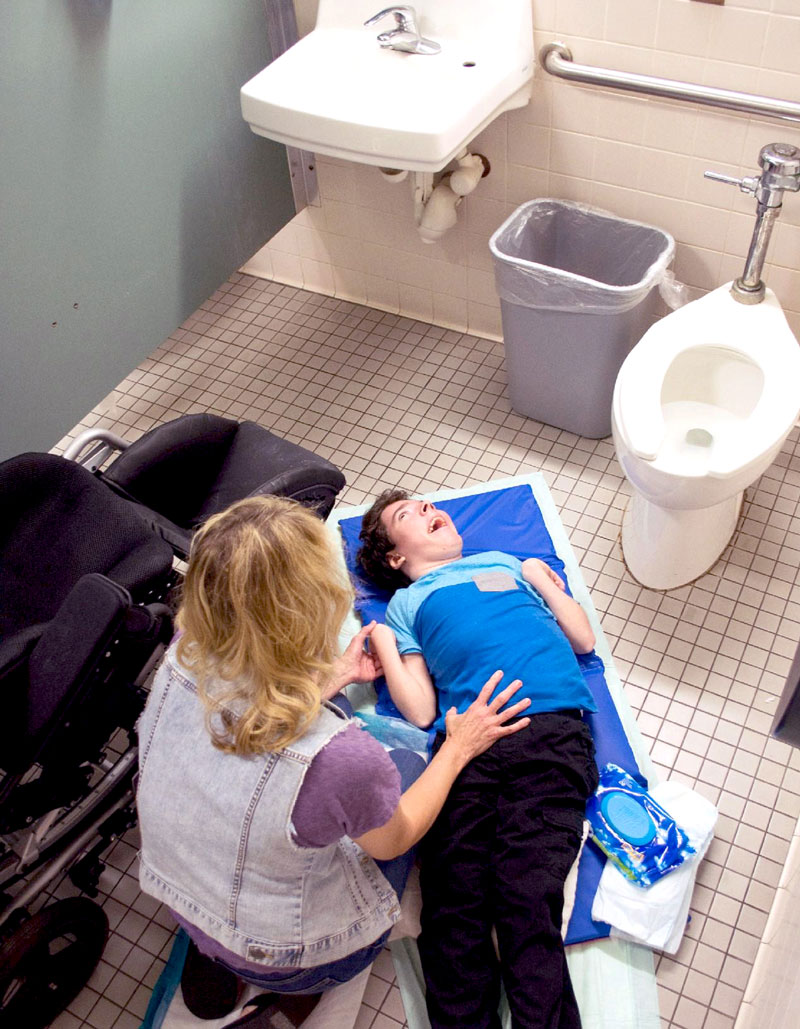
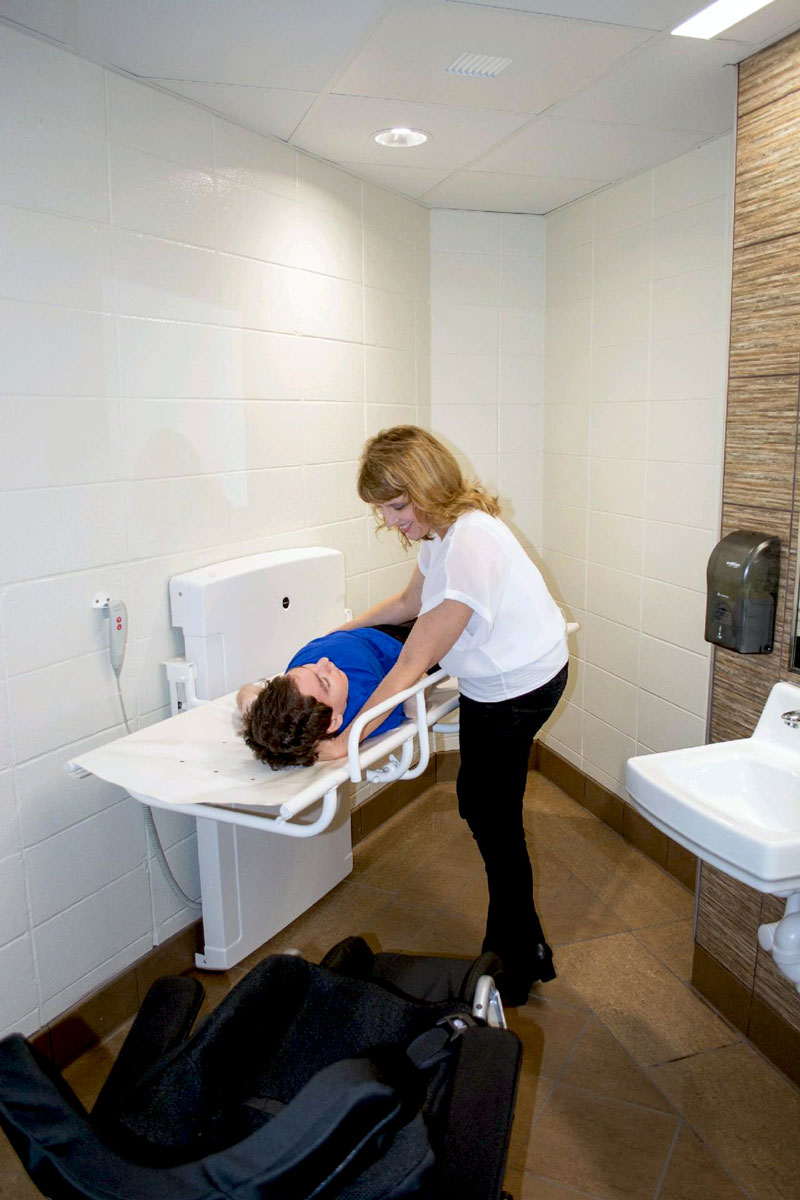
PHOTO COURTESY OF UNIVERSAL CHANGING PLACES
A Dilemma for Those with Disabilities
Currently, there are few options in public places for where caregivers can attend to the bathroom needs of someone with a disability both safely and discreetly.
Assuming a caretaker can lift the person with a disability, the floor in a handicapped stall may be used — although the door will probably be left open as these generally lack sufficient space — or where no stall is available, an open area in a restroom. In addition to inherently lacking privacy by being visible to onlookers, these arrangements can also expose the person being assisted to cold, wet and unsanitary conditions that could potentially harm their health.
In places where there are no public restrooms, or where space inside of restrooms is unavailable, caregivers may struggle to assist someone who has a disability by attending to them inside a vehicle such as a van. If that’s not possible, they may lay them on the grass in a park or other outdoor area, where hopefully, they can find a secluded spot where they’re less likely to be observed.
In order to avoid situations like these, individuals who have disabilities often choose to avoid travel and going to public places like stores, restaurants, entertainment venues or other places they might otherwise want to visit. In the process, they become increasingly isolated over time which can result in mental health problems.
The Only Constant is Inconsistency
In 2015, California became the first state to require assistive tables in commercial places of public amusement. Since then, several other states have also passed laws requiring them, while some other states are in the process of considering legislation mandating their presence as well.
While indicative of a growing trend, the problem with these laws, Guard suggests, is that “because these products (assistive tables) are newer, requirements for them vary across the United States. Product definitions and product types differ from state-to-state, as well as the effective dates for compliance and places where the products are mandatory. Even the definitions in each state for building type vary.
“This patchwork regulatory environment,” Guard adds, “creates a significant challenge for people who have disabilities and their caregivers as they move about the country in terms of knowing what to expect, as well as for those bringing new products to market who need to know if they’ll be compliant.
The solution for this, according to Guard, is for states and other jurisdictions to adopt uniform product and installation requirements into their building and safety codes, thus flattening the regulatory landscape and, as codes get implemented, achieving consistency.
“That’s where IAPMO really shines,” Guard says, “because the UPC is a base model code that’s easy for jurisdictions to adopt. They don’t have to develop their own language or figure out which product requirements are good or bad since the IAPMO UPC Technical Committee, who are the experts, has already done the work for them. What more could you ask for?”
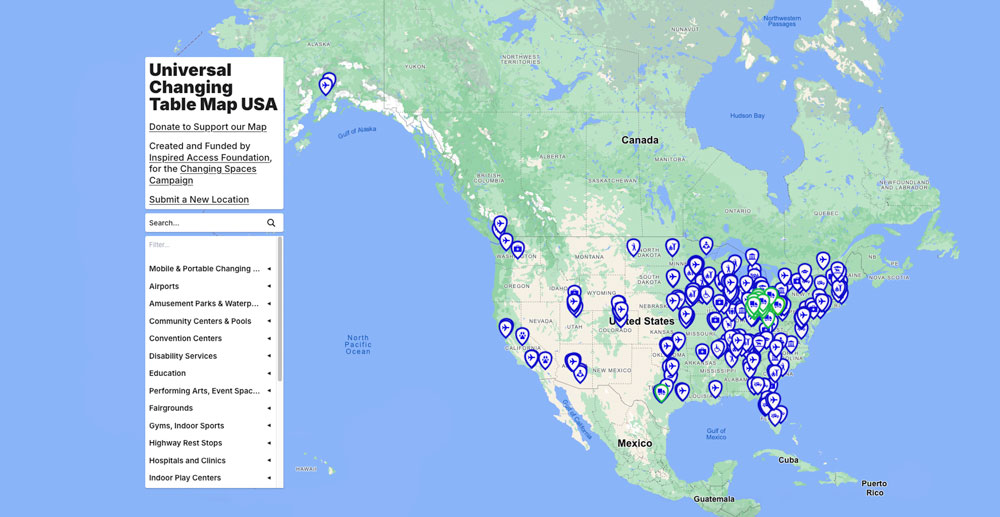
As assistive tables are added across the country, the Changing Spaces Campaign tracks them with an online map showing their location along highways and in places like entertainment, educational institutions, health care facilities and business establishments.
GRAPHIC COURTESY OF INSPIRED ACCESS FOUNDATION
Paving the Way with the UPC
Updated every three years, IAPMO is currently developing its 2027 UPC, a process with which Guard is also involved, this time by providing public testimony to guide its language and content development.
According to IAPMO’s UPC Development Administrator Enrique Gonzalez, “the UPC is unique in that it is the only model plumbing code developed in accordance with the American National Standards Institute’s (ANSI) accredited, consensus process.”
As part of this process, IAPMO brings together installers, plumbing officials, representatives from the construction industry, engineers, manufacturers and other experts, as well as members of the public that include individuals with disabilities, their families and their caregivers, to agree on requirements that policy makers can then adopt as base model code requirements in their own jurisdictions.
Since the UPC is also an American National Standard, it’s subject to ANSI’s neutral oversight and approval, which Gonzalez says means that “ANSI audits the process to make sure you’re following their guidelines by doing things like checking the documentation, looking at the voting and making sure there’s been public input.”
This approach results in a code that provides installers, inspectors and other code-users with minimum health and safety requirements with which products need to comply, so that in places where the UPC has been approved, they can look at a product and know whether or not it complies with an ANSI consensus standard.
Gonzalez describes the UPC as a “living and breathing” document as the 2027 UPC code development process began almost immediately after the 2024 version was released, or as Guard puts it, “almost before the ink was dry.”
The next step in the procedure will be the publication of a Report on Comments (ROC) Monograph on March 31, containing public comments to be discussed at a Technical Committee Hearing in Los Angeles on May 6-7. This event is also open to the public, with additional details regarding it to be posted on IAPMO’s home page.
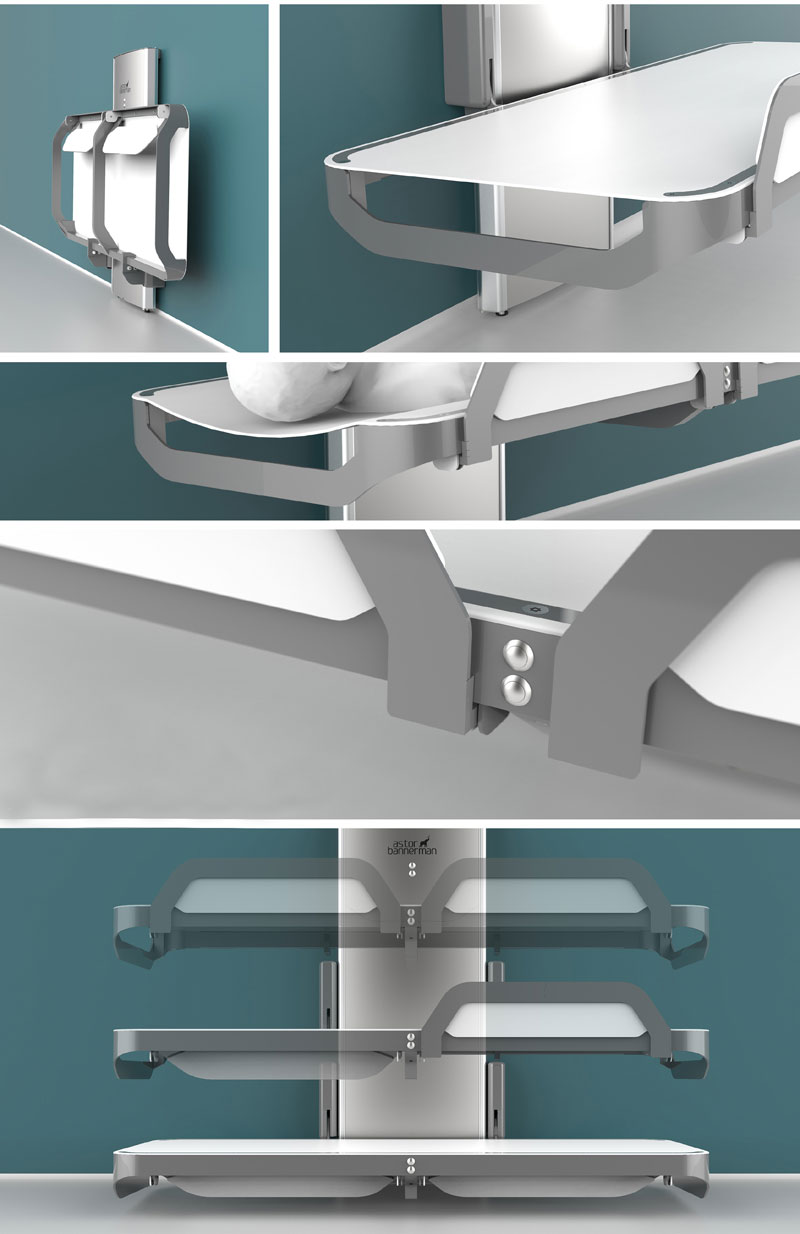
Astor-Bannerman’s “Invincible” model is an example of a powered height-adjustable assistive table.
PHOTO COURTESY OF ASTOR-BANNERMAN
Changing the Future of Accessibility
According to Guard, “acknowledgement of the need for more inclusive public restrooms has been steadily growing worldwide,” and with that, recognition of the fact that those with disabilities represent a significant and important population that could benefit by having greater access to them.
Based on statistics from the 2021 American Community Survey conducted by the U.S. Census Bureau, 42.5 million Americans reported having a disability, with 46% of those 75 years of age and older, 24% between the ages of 65 and 74, 12% ages 35 to 64, and 8% under 35. Of these, 12.2% reported having mobility problems, 7.7% were challenged by independent living, and 3.6% had difficulties providing self-care.
“This means,” Guard says, “we’re talking about millions of people who would positively benefit through the availability and use of assistive tables. With greater access to these products, they could experience improved health and mental well-being, be better able to engage with their community and the economy, and have enhanced employment prospects.”
As awareness of these benefits grows, she adds, “businesses have also taken note and started to provide assistive tables, first in the travel industry, followed by public space accommodations, and now in retail establishments,” where they can impact the bottom line by creating loyal customers.
By providing requirements developed by experts, and guided by a proven process that includes public participation, the UPC gives public officials a base model code they can adopt and use to create greater consistency and accelerate the installation of assistive tables into more and more buildings across the country.
So, whether they’re located in airports, schools, big-box retail stores, malls, museums, restaurants, sports venues or other public places, their presence will allow people who have disabilities to go there without having to worry about the availability of inclusive toilet facilities and give them a greater sense of personal dignity when they need to use them.
Most importantly, by increasing their mobility, assistive tables will give an important segment of our society the opportunity to participate more fully in the fabric of American life. Which is a change we can all appreciate.
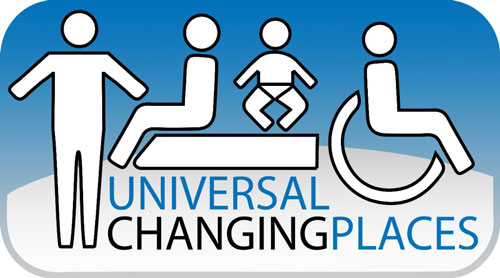
Universal Changing Places is a grass roots organization that wants to bring awareness of the need for powered height- adjustable assistive tables in family/companion care restrooms.
Sabrina Kimball, founder of Universal Changing Places
Ph: (850) 408-8586
E: UCPlaces@gmail.com
universalchangingplaces.com

Stephen Webb
Last modified: February 5, 2025
